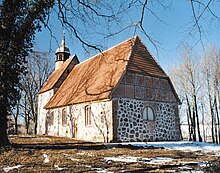District of Lübz
The Lübz district was a district of the Schwerin district in the GDR . From May 17, 1990, it continued as the district of Lübz . Today his area belongs to the Ludwigslust-Parchim district in Mecklenburg-Western Pomerania . The seat of the district administration was in Lübz .
location
The area of the former district is rich in lakes. The Plauer See was the third largest lake in the GDR, and the Goldberger See , the Dobbertiner See and the Damerower See are also noteworthy . The North Sea-Baltic Sea watershed runs between Lübz and Goldberg. While the Plauer See and the Müritz-Elde-Wasserstraße (MEW) flowing through it drain over the Elbe into the North Sea, the Mildenitz , which rises just a few kilometers north of the MEW, flows into the Warnow and thus discharges the water into the Baltic Sea. Elevations in the former Lübz district are, for example, the Buchberg at 118 m above sea level. NN south of Gnevsdorf , the Kläterberg (83 m) and the Haideberg (81 m) east of Klein Wangelin , the Siebeneichenberg (83 m) northeast of Penzlin and the Weizenberg (82 m) between Plau and Plauerhagen . The 91 meter high Klüschenberg in Plau was used to grow wine in the 16th century. The north of the district, which was located within the Schwinzer Heide , was characterized by its wealth of forests. In the rest of the district, the agricultural areas predominated. The Ture landscape is located around Lübz . The name is derived from the Slavic Tur , which means something like aurochs . An office of the same name existed since 1991 .
Area and inhabitants
The area of the district was 700 km². That corresponded to 8.1% of the area of the Schwerin district. The number of inhabitants in 1985 was about 34,000. That was 5.7% of the residents of the district. The population density was 49 inhabitants per km².
Neighboring areas
The district of Lübz bordered the district of Güstrow in the north, the district of Sternberg in the northwest and the district of Parchim in the west . Neighboring districts in the Neubrandenburg district were the districts of Waren in the east and Röbel / Müritz in the southeast. In addition, the district of Lübz bordered the districts of Wittstock in the southeast and Pritzwalk in the south, which belonged to the former Potsdam district .
history
The Mecklenburg district was established on July 25, 1952 from the eastern half of the old Parchim district and belonged to the newly formed Schwerin district. The western half formed the Parchim district . On May 17, 1990, the district became the district of Lübz. He came to the newly founded state of Mecklenburg-Western Pomerania on October 3, 1990 within the accession area to the Federal Republic of Germany . On June 12, 1994 the district of Lübz was dissolved. With the Parchim district and parts of the Sternberg district and the Schwerin-Land district , he came to the new Parchim district .
Economy and Infrastructure
Agriculture found soils of medium quality in the Lübz district. Mainly sugar beets, potatoes and rye were grown. The north was used for forestry. The largest fur farm in the GDR was located in Plau-Appelburg . A sugar factory and a dairy were located in Lübz, the Mecklenburg Brewery Lübz , which has been in existence since 1877, and the mineral wool factory are still producing today. In Goldberg there was a clothes factory, in Plau there was a factory for electronic components, a furniture industry and a cheese factory. Even then, the tourism industry was strongly represented, especially on the lakes.
The trunk roads 103 ran through the district of Lübz in a north-south direction, 191 and 192 in a west-east direction. The Hamburg-Berlin motorway ran south of the district, and the Rostock-Berlin motorway to the east . From the important transfer station in Karow , railway lines led to Parchim, Güstrow, Sternberg, Waren and Meyenburg.
cities and communes
On October 3, 1990, the district of Lübz had 28 municipalities, including three cities:
- Barkov
- Broock
- Diestelow
- Dobbertin
- Gallin
- Ganzlin
- Gischow
- Gnevsdorf
- Goldberg , city
- Granzin
- Karbow-Vietlübbe
- Karow
- Circling
- Kritzow
- Cupentess
- Langenhagen
- Lübz , city
- Lutheran
- New poserin
- Passow
- Plau , city
- Plauerhagen
- Retzow
- Techentin
- Wahlstorf
- Wendisch Priborn
- Wendish goods
- Werder
License Plate
Motor vehicles (with the exception of motorcycles) and trailers were assigned three-letter distinctive signs starting with the letter pairs BI and BJ from around 1974 to the end of 1990 . The last number plate series used for motorcycles was BS 78-36 to BS 99-99 .
At the beginning of 1991 the district received the distinguishing mark LBZ . It was issued until June 11, 1994. It has been valid since August 1, 2013 due to the license plate liberalization in the Ludwigslust-Parchim district .
Individual evidence
- ↑ a b Federal Statistical Office (ed.): Municipalities 1994 and their changes since 01.01.1948 in the new federal states . Metzler-Poeschel, Stuttgart 1995, ISBN 3-8246-0321-7 .
- ↑ Law on the self-administration of municipalities and districts in the GDR (municipal constitution) of May 17, 1990
- ↑ On January 11, 1994, the name of the town Plau was supplemented by the addition of am See .
- ↑ Andreas Herzfeld: The history of the German license plate . 4th edition. German Flag Society V., Berlin 2010, ISBN 978-3-935131-11-7 , pp. 301 .
- ↑ Andreas Herzfeld: The history of the German license plate . 4th edition. German Flag Society V., Berlin 2010, ISBN 978-3-935131-11-7 , pp. 550 .



